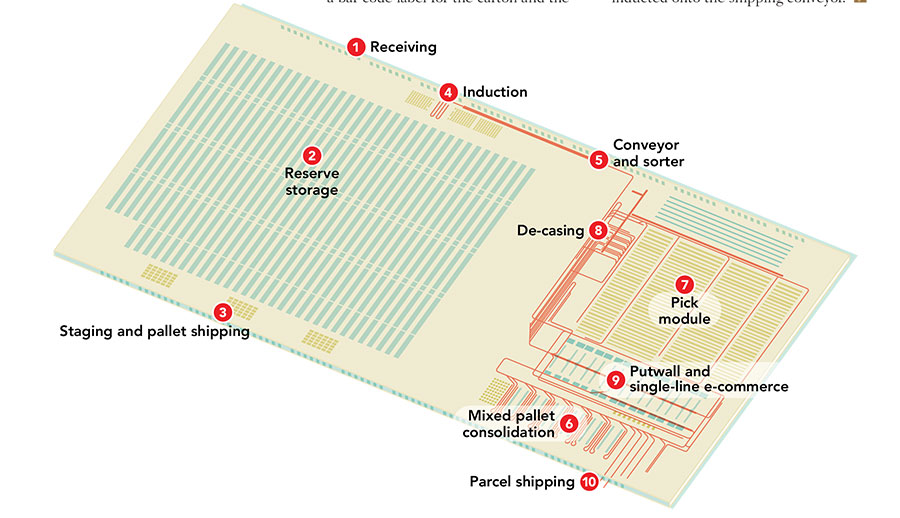Inside the Caleres distribution center: Right shoe, right place, right time
Take an inside look at the new Caleres distribution center.

From the Issue of
Modern Materials Handling
Caleres, Inc.
Chino, Calif.
SIZE: 725,000 square feet. The facility is one of 5 buildings in North America totaling 2.4 million square feet
CHANNELS SERVICED: The facility provides case fulfillment for large retail partners and wholesale multi-brand e-commerce.
PRODUCTS HANDLED: Footwear and accessories
SKUS: 200,000+
THROUGHPUT: The system is designed to process 200,000 units per day
EMPLOYEES: 200
SHIFTS PER DAY/DAYS PER WEEK: 2 shifts, 7 days a week
Caleres’ new DC, one of two facilities in Chino, Calif., was designed to reduce costs and minimize labor in a tight labor market, by employing automation to take touches out of the system.
Check out the feature article about the Caleres distribution center.
Receiving and storage
Containers of floor-loaded product are received from the nearby port. Cartons are unloaded onto flexible conveyor and then palletized (1) in receiving for putaway into the reserve pallet storage (2). Putaway is system-directed and lift truck operators scan the pallets into a designated storage location in the pallet storage area.
Replenishment
Cases are inducted onto the conveyor system and delivered to the pick module (7) as needed.
Picking
The facility supports at least three channels, including retail store fulfillment; wholesale fulfillment; and e-commerce fulfillment for wholesale partners and e-commerce partners like Amazon and Zappos, to name a few. Within, the system was designed to support three picking processes:
- Ship Without Packaging, or SWOP, are full case or full pallet orders that ship without any repacking,
- pick-to-carton, or mixed case picking, to send to wholesale partners, and
- direct-to-consumer orders for wholesale and e-commerce-related customers.
SWOP
Full pallets orders are delivered by lift truck to a consolidation area in shipping (3). They are staged there until a customer truck arrives and they are loaded onto the outbound trailer. Meanwhile, full cases for mixed pallet are inducted (4) onto the conveyor and sortation system (5) and sorted to the mixed pallet consolidation area (6). Mixed pallets are built, stretch-wrapped and staged in the consolidation area until a customer trailer arrives for pickup. Case orders are loaded onto a parcel carrier for immediate shipment.
Pick-to-carton and e-fulfillment
Mixed cases and e-commerce orders are filled with a two- and sometimes three-step process. In the first step, full cases are picked in a pick module (7) and conveyed and sorted to a de-casing area (8), which is essentially a goods-to-person processing area. When a case is sorted to a workstation, an associate opens the carton, and places the required number of shoes on a belt conveyor that will deliver them to the next step in the order fulfillment process. If the donor carton wasn’t depleted, it’s placed on a center take-away conveyor to go back to reserve storage.

In the second step, associates create mixed SKU cartons. In this process, the warehouse management system (WMS) creates a wave of 2,200 orders, which represents the number of storage locations in a light-directed putwall area (9). A sliding shoe sorter diverts the shoes to a chute that leads to the right putwall location for that order. The shoes are queued on carton flow rack. When all of the pairs for a carton are in a location, a light alerts an associate that the order is ready to be packed. The system prints a bar code label for the carton and the associate loads the shoes into the carton.
Since these are wholesale orders, most cartons will be conveyed upstairs to a value-added services area (not shown), where the order will be finished according to the customer’s specifications. This is the third step. Once the value-added services are complete, the carton is placed back on the conveyor to be transported to shipping. Once the cartons have been automatically taped, scanned and labeled with a shipping label, they are sorted to the right outbound trailer and automatically loaded by conveyor in the parcel shipping area (10).
Single-line e-commerce orders are conveyed directly from the decasing area to consolidation, or shipping. Multi-line orders are conveyed to a smaller shelving unit area in the putwall area – but not included in the 2,200 locations in the putwall. Once all of the items for an order are in place, they are packed and inducted onto the shipping conveyor.
System suppliers
SYSTEM INTEGRATION & WAREHOUSE EXECUTION SYSTEM: enVista
WMS: Manhattan Associates
PRINT-AND-APPLY: ID Technology
BAR CODE SCANNING: Cognex
CONVEYOR AND SORTATION: Hytrol
AUTOMATIC TRUCK LOADING: FMH Conveyors (BestReach)
PUTWALL: Lightning Pick
PICK MODULE & MEZZANINE: Elite Storage Solutions
RACK: Interlake Mecalux
LIFT TRUCK: Raymond

Article Topics
Software News & Resources
C-suite Interview with Keith Moore, CEO, AutoScheduler.AI: MODEX was a meeting place for innovation C-Suite Interview with Frank Jewell of Datex, Leading the Way in the Material Handling Industry Give your warehouse management systems (WMS) a boost Agility Robotics and Manhattan Associates partner to bring AI-powered humanoid robots into warehouses Siemens, Universal Robots, and Zivid partner to unveil smart robotic picking solution OTTO Motors showcases latest software release for optimizing floor space Rite-Hite ONE digital platform debuts More SoftwareLatest in Materials Handling
Beckhoff USA opens new office in Austin, Texas Manhattan Associates selects TeamViewer as partner for warehouse vision picking ASME Foundation wins grant for technical workforce development The (Not So) Secret Weapons: How Key Cabinets and Asset Management Lockers Are Changing Supply Chain Operations MODEX C-Suite Interview with Harold Vanasse: The perfect blend of automation and sustainability Consultant and industry leader John M. Hill passes on at age 86 Registration open for Pack Expo International 2024 More Materials HandlingAbout the Author
Subscribe to Materials Handling Magazine

Find out what the world's most innovative companies are doing to improve productivity in their plants and distribution centers.
Start your FREE subscription today.
April 2024 Modern Materials Handling

Latest Resources










